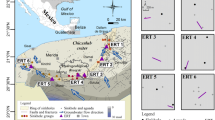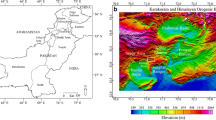Abstract
Stratigraphic heterogeneity is a key controlling factor for flow and transport in groundwater systems. In this case study, we have combined two- and three-dimensional images of electric resistivity with hydrogeological data to delineate such stratigraphic heterogeneity at a loop of River Steinlach close to Tübingen, Germany, where we estimated spatially varying aquifer parameters using established evaluation techniques. We developed a three-layer stratigraphic model consisting of heterogeneous sandy gravel overlain by a fine alluvium including top soil, and underlain by sandstone weathered at its top. The sandy gravel makes up the aquifer unit while we interpret the sandstone as aquitard. We classified the area into two stratigraphic segments based on resistivity data. The Southern segment consists of a thicker alluvium where the aquifer material contains more clay than in the Northern segment. Two different stratigraphic structures were also delineated at the Southern and Northern segments, respectively. These structures are visible in inversion results as low-resistivity features trending in the SE–NW in the Southern segment and NE–NW in the Northern segment. Both structures may be previous flow paths of River Steinlach, and the low permeability material overlying them may impair flow exchange in the area. We performed slug and pumping tests to estimate the hydraulic conductivity (K) of the aquifer. The K distributions show slight variation with higher values obtained at wells within the Northern segment and close to the river bank. A qualitative comparison of measured hydraulic conductivities with the resistivity distribution shows good agreement of the spatial patterns. The stratigraphic and hydraulic heterogeneities delineated in this work are important for experimental and modeling studies of flow, transport, and hyporheic exchange at the site.








Similar content being viewed by others
References
Ahmed S, de Marsily G, Talbot A (1988) Combined use of hydraulic and electrical properties of an aquifer in a geostatistical estimation of transmissivity. Ground Water 26:78–86. doi:10.1111/j.1745-6584.1988.tb00370.x
Aizebeokhai AP, Olayinka AI, Singh VS (2010) Application of 2D and 3D geoelectrical resistivity imaging for engineering site investigation in a crystalline basement terrain, southwestern Nigeria. J Environ Earth Sci. p 1481. doi:10.1007/s12665-010-0474-z
Al-Ajmi H, Hinderer M, Keller M, Rausch R, Blum P, Bohnsack D (2011) The role of outcrop analogue studies in for the characterization of aquifer properties. Int J Water Resour Arid Environ 1:48–54
Batayneh AT (2009) A hydrogeophysical model of the relationship between geoelectric and hydraulic parameters. J Water Resour Prot 1:400–407
Binley A, Kemna A (2005) DC resistivity and induced polarization methods. In: Rubin Y, Hubbard SS (eds) Hydrogeophysics. Springer, Netherlands, pp 129–156
Bohling GC, Zhan X, Butler JJ Jr, Zheng L (2002) Steady shape analysis of tomographic pumping tests for characterization of aquifer heterogeneities. Water Resour Res 38:1324. doi:10.1029/2001wr001176
Bouwer H, Rice RC (1976) A slug test for determining hydraulic conductivity of unconfined aquifers with completely or partially penetrating wells. Water Resour Res 12(3):423–428. doi:10.1029/WR012i003p00423
Bowling JC, Rodriguez AB, Harry DL, Zheng C (2005) Delineating alluvial aquifer heterogeneity using resistivity and GPR data. Ground Water 43:890–903. doi:10.1111/j.1745-6584.2005.00103.x
Bowling JC, Zheng C, Rodriguez AB, Harry DL (2006) Geophysical constraints on contaminant transport modeling in a heterogeneous fluvial aquifer. J Contam Hydrol 85:72–88. doi:10.1016/j.jconhyd.2006.01.006
Bowling JC, Harry DL, Rodriguez AB, Zheng C (2007) Integrated geophysical and geological investigation of a heterogeneous fluvial aquifer in Columbus Mississippi. J Appl Geophys 62:58–73. doi:10.1016/j.jappgeo.2006.08.003
Butler JJ (2005) Hydrogeological methods for estimation of spatial variations in hydraulic conductivity. In: Rubin Y, Hubbard SS (eds) Hydrogeophysics. Springer, Netherlands, pp 23–58
Butler JJ, Healey JM (1998) Relationship between pumping-test and slug-test parameters: scale effect or artifact? Ground Water 36:305–312. doi:10.1111/j.1745-6584.1998.tb01096.x
Cardenas MB, Markowski MS (2011) Geoelectrical imaging of hyporheic exchange and mixing of river water and groundwater in a large regulated river. American Chemical Society, Washington, DC
Cardiff M, Barrash W (2011) 3-D transient hydraulic tomography in unconfined aquifers with fast drainage response. Water Resour Res 47:W12518. doi:10.1029/2010wr010367
Cassiani G, Medina MA (1997) Incorporating Auxiliary Geophysical Data into Ground-Water Flow Parameter Estimation. Ground Water 35:79–91. doi:10.1111/j.1745-6584.1997.tb00063.x
Chambers JE, Wilkinson PB, Weller AL, Meldrum PI, Ogilvy RD, Caunt S (2007) Mineshaft imaging using surface and crosshole 3D electrical resistivity tomography: a case history from the East Pennine Coalfield, UK. J Appl Geophys 62:324–337. doi:10.1016/j.jappgeo.2007.03.004
de Groot-Hedlin CD, Constable SC (1990) Occam’s inversion to generate smooth, twodimensional models from magnetotelluric data. Geophysics 55(12):1613–1624
Dietrich P, Fechner T, Whittaker J, Teutsch G (1998) An integrated hydrogeophysical approach to subsurface characterization. Groundwater quality: remediation and protection. IAHS, Tuebingen, Germany
Freeze RA, Cherry JA (1979) Groundwater. Prentice Hall, Inc., Upper Saddle River
Frohlich RK, Kelly WE (1988) Estimates of specific yield with the geoelectric resistivity method in glacial aquifers. J Hydrol 97:33–44. doi:10.1016/0022-1694(88)90064-9
Grathwohl P, Rügner H, Wöhling T, Osenbrück K, Schwientek M, Gayler S, Wollschläger U, Selle B, Pause M, Delfs J-O, Grzeschik M, Weller U, Ivanov M, Cirpka OA, Maier U, Kuch B, Nowak W, Wulfmeyer V, Warrach-Sagi K, Streck T, Attinger S, Bilke L, Dietrich P, Fleckenstein JH, Kalbacher T, Kolditz O, Rink K, Samaniego L, Vogel H-J, Werban U, Teutsch G (2013) Catchments as reactors—a comprehensive approach for water fluxes and solute turn-over. Environ Earth Sci 69(2). doi:10.1007/s12665-013-2281-7
Heigold PC, Gilkeson RH, Cartwright K, Reed PC (1979) Aquifer transmissivity from surficial electrical methods. Ground Water 17:338–345. doi:10.1111/j.1745-6584.1979.tb03326.x
Hubbard SS, Rubin Y (2000) Hydrogeological parameter estimation using geophysical data: a review of selected techniques. J Contam Hydrol 45:3–34. doi:10.1016/s0169-7722(00)00117-0
Hubbard SS, Chen J, Peterson J, Majer EL, Williams KH, Swift DJ, Mailloux B, Rubin Y (2001) Hydrogeological characterization of the south oyster bacterial transport site using geophysical data. Water Resour Res 37:2431–2456. doi:10.1029/2001wr000279
Hyndman DW, Harris JM, Gorelick SM (2000) Inferring the relation between seismic slowness and hydraulic conductivity in heterogeneous aquifers. Water Resour Res 36:2121–2132. doi:10.1029/2000wr900112
Kelly WE, Frohlich RK (1985) Relations between aquifer electrical and hydraulic properties. Ground Water 23:182–189. doi:10.1111/j.1745-6584.1985.tb02791.x
Kosinski WK, Kelly WE (1981) Geoelectric soundings for predicting aquifer properties. Ground Water 19:163–171. doi:10.1111/j.1745-6584.1981.tb03455.x
Koster JW, Harry DL (2005) Effects of water saturation on a resistivity survey of an unconfined fluvial aquifer in Columbus, MS. Hydrol Days 2005:111–120
Loke MH (2011) Tutorial: 2D and 3D electrical imaging surveys, edited. p 172. http://www.geoelectrical.com
Loke MH, Acworth I, Dahlin T (2003) A comparison of smooth and blocky inversion methods in 2D electrical imaging surveys. Explor Geophys 34:182–187
Mastrocicco M, Vignoli G, Colombani N, Zeid N (2010) Surface electrical resistivity tomography and hydrogeological characterization to constrain groundwater flow modeling in an agricultural field site near Ferrara (Italy). Environ Earth Sci 61:311–322. doi:10.1007/s12665-009-0344-6
Maurer H, Friedel S, Jaeggi D (2009) Characterization of a coastal aquifer using seismic and geoelectric borehole methods. Near Surf Geophys 7:353–366
Mazac O, Kelly WE, Landa I (1987) Surface geoelectrics for groundwater pollution and protection studies. J Hydrol 93:277–294. doi:10.1016/0022-1694(87)90100-4
Mazác O, Kelly WE, Landa I (1985) A hydrogeophysical model for relations between electrical and hydraulic properties of aquifers. J Hydrol 79:1–19. doi:10.1016/0022-1694(85)90178-7
Mucha I, Bansky LU, Hlavaty Z, Rodak D (2006) Impact of riverbed clogging–colmation: on groundwater. In: Hubbs SA (ed) Riverbank filtration hydrology: impacts on system capacity and water quality. Springer, Netherlands, pp 43–72
Niwas S, de Lima OAL (2003) Aquifer parameter estimation from surface resistivity data. Ground Water 41:94–99. doi:10.1111/j.1745-6584.2003.tb02572.x
Osenbrück K, Wöhling T, Lemke D, Rohrbach N, Schwientek M, Leven C, Callisto Alvarez C, Taubald H, Cirpka OA (2013) Lateral hyporheic exchange fluxes at the Steinlach Test Site, Germany derived from hydraulic, chemical and isotopic monitoring. Environ Earth Sci 69(2). doi:10.1007/s12665-012-2155-4
Pollock D, Cirpka OA (2008) Temporal moments in geoelectrical monitoring of salt tracer experiments. Water Resour Res 44:W12416. doi:10.1029/2008wr007014
Pollock D, Cirpka OA (2010) Fully coupled hydrogeophysical inversion of synthetic salt tracer experiments. Water Resour Res 46:W07501. doi:10.1029/2009wr008575
Pollock D, Cirpka OA (2012) Fully coupled hydrogeophysical inversion of a laboratory salt tracer experiment monitored by electrical resistivity tomography. Water Resour Res 48:W01505. doi:10.1029/2011wr010779
Purvance DT, Andricevic R (2000a) Geoelectric characterization of the hydraulic conductivity field and its spatial structure at variable scales. Water Resour Res 36:2915–2924. doi:10.1029/2000wr900187
Purvance DT, Andricevic R (2000b) On the electrical-hydraulic conductivity correlation in aquifers. Water Resour Res 36:2905–2913. doi:10.1029/2000wr900165
Reynolds JM (1997) An introduction to applied and environmental geophysics. Wiley, England, UK, p 778
Rovey CW, Cherkauer DS (1995) Scale dependency of hydraulic conductivity measurements. Ground Water 33:769–780. doi:10.1111/j.1745-6584.1995.tb00023.x
Sasaki Y (1992) Resolution of resistivity tomography inferred from numerical simulation. Geophys Prospect 40:453–464
Sinha R, Israil M, Singhal D (2009) A hydrogeophysical model of the relationship between geoelectric and hydraulic parameters of anisotropic aquifers. Hydrogeol J 17:495–503. doi:10.1007/s10040-008-0424-9
Springer RK, Gelhar LW (1991) Characterization of large-scale aquifer heterogeneity in glacial outwash by analysis of slug tests with oscillatory response, Cape Cod, Massachusetts, US Geol Surv Water Res Invest Rep 91-4034, pp 36–40
Telford WM, Geldart LP, Sheriff RE (1990) Applied geophysics, 2nd edn. Cambridge University Press, New York
Theis CV (1935) The relation between the lowering of the piezometric surface and the rate and duration of discharge of a well using groundwater storage. Trans Am Geophys Union 16:519–524
Vereecken H, Kemna A, Münch H-M, Tillmann A, Verweerd A (2006) Aquifer characterization by geophysical methods. Encyclopedia of hydrological sciences. Wiley, New York
Ward AS, Gooseff MN, Singha K (2010) Imaging hyporheic zone solute transport using electrical resistivity. Hydrol Process 24:948–953. doi:10.1002/hyp.7672
Yeh TCJ, Liu S (2000) Hydraulic tomography: development of a new aquifer test method. Water Resour Res 36:2095–2105. doi:10.1029/2000wr900114
Yeh TCJ, Liu S, Glass RJ, Baker K, Brainard JR, Alumbaugh D, LaBrecque D (2002) A geostatistically based inverse model for electrical resistivity surveys and its applications to vadose zone hydrology. Water Resour Res 38:1278. doi:10.1029/2001wr001204
Zhou B, Dahlin T (2003) Properties and effects of measurement errors on 2D resistivity imaging surveying EAGE. Near Surf Geophys 1:105–117
Acknowledgments
The authors are grateful to Dennis Lemke, Marc Schwientek, Karsten Osenbrück, Thomas Woehling and the members of the Water and Earth System Science (WESS) competence cluster, Tübingen, for their support during the field work and provision of other logistics to ensure the successful completion of this work. Financial support was given by the German Federal Ministry of Education and Research (BMBF) within the “Geotechnologien” program, subprogram “Tomography of the Earth’s Crust”, project “TOMOME: tomographic methods in hydrogeology”. We also want to thank three anonymous reviewers for providing valuable comments that helped to improve this manuscript.
Author information
Authors and Affiliations
Corresponding author
Rights and permissions
About this article
Cite this article
Doro, K.O., Leven, C. & Cirpka, O.A. Delineating subsurface heterogeneity at a loop of River Steinlach using geophysical and hydrogeological methods. Environ Earth Sci 69, 335–348 (2013). https://doi.org/10.1007/s12665-013-2316-0
Received:
Accepted:
Published:
Issue Date:
DOI: https://doi.org/10.1007/s12665-013-2316-0




